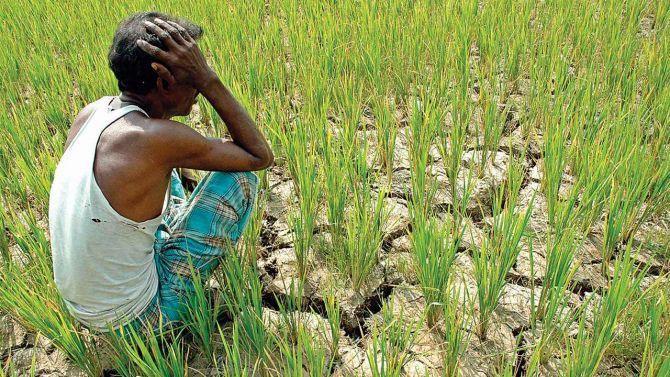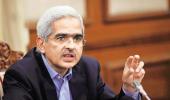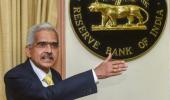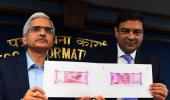Here are the key decisions announced by the Reserve Bank of India on Thursday.

The Reserve Bank of India on Thursday raised the limit of collateral-free agricultural loans to Rs 1.6 lakh from the current Rs 1 lakh with a view to help small and marginal farmers.
The central bank also decided to set up an internal working group to review agricultural credit and arrive at a workable policy solution.
The Union Budget had also announced measures to farming sector in addition annual payment of Rs 6,000 to small and marginal farmers.
Currently, the banks are mandated to extend collateral-free agricultural loans up to Rs 1 lakh. This limit was fixed in the year 2010.
"Keeping in view the overall inflation and rise in agriculture input costs since then, it has been decided to raise the limit for collateral–free agriculture loans from Rs 1 lakh to Rs 1.6 lakh.
"This will enhance coverage of small and marginal farmers in the formal credit system," said the central bank's 'Statement on Developmental and Regulatory Policies'.
A circular in this regard will be issued shortly, it added.
It further said agricultural credit growth has been significant over the years.
In spite of this, there remain issues related to agricultural credit such as regional disparity and the extent of coverage, among others.
"There is also the issue of deepening long-term agricultural credit for capital formation," the RBI said while announcing setting up of the IWG.
The IWG will examine issues related to agricultural credit and arrive at workable solutions and policy initiatives.
FY20 GDP likely to be 7.4 pc
The RBI on Thursday projected an economic growth rate of 7.4 per cent for the next fiscal, up from 7.2 per cent estimated for the current fiscal by Central Statistics Office (CSO).
The gross domestic product growth is likely to be influenced by growth in bank credit and overall financial flows to the commercial sectors, though slowing global demand could play a dampener, said an RBI document released after the three-day meeting of the central bank's Monetary Policy Committee (MPC).
The RBI had projected the GDP growth for 2018-19 in the December policy at 7.4 per cent (7.2-7.3 per cent in H2) and at 7.5 per cent for H1:2019-20, with risks somewhat to the downside.
The CSO has estimated GDP growth at 7.2 per cent for 2018-19.
"Looking beyond the current year, the growth outlook is likely to be influenced by... aggregate bank credit; and overall financial flows to the commercial sector continue to be strong, but are yet to be broad-based," the MPC said.
It further said that in spite of soft crude oil prices and the lagged impact of the recent depreciation of the Indian rupee on net exports, slowing global demand could pose headwinds.
"In particular, trade tensions and associated uncertainties appear to be moderating global growth," it said.
RBI governor and member of the MPC Shaktikanta Das said the risks are evenly balanced for growth.
The six-member MPC, headed by Das, also noted that the output gap has opened up modestly as actual output has inched lower than potential.
Investment activity is recovering, but supported mainly by public spending on infrastructure, it said.
‘The need is to strengthen private investment activity and buttress private consumption, said the MPC document, as the central bank reduced the key lending rate by 0.25 per cent, for the first time in the current fiscal.
Q4 Inflation rate down to 2.8 pc
The RBI on Thursday revised downwards the retail inflation forecast to 2.8 per cent for the last quarter of the current fiscal on account of favourable factors including a benign monsoon.
The RBI in its last bi-monthly monetary policy announcement for the current fiscal also lowered the retail inflation forecast for the first half of next fiscal beginning April, to 3.2-3.4 per.
For the third quarter of 2019-20, the inflation target is set at 3.9 per cent.
"Several factors will shape the inflation path, going forward. First, food inflation has continued to surprise on the downside with continuing deflation across several items and a significant moderation in inflation in cereals. Several food groups are experiencing excess supply conditions domestically as well as internationally," the RBI said.
RBI said the short-term outlook for food inflation appears particularly benign, despite adverse base effects.
"These decisions are in consonance with the objective of achieving the medium-term target for consumer price index (CPI) inflation of 4 per cent within a band of plus/minus 2 per cent, while supporting growth," the RBI said.
The moderation in the fuel group was larger than anticipated. Inflation in items of rural consumption such as firewood and chips, which had remained sticky and at elevated levels, has collapsed in recent months, it added.
"Taking into consideration these developments and assuming a normal monsoon in 2019, the path of CPI inflation is revised downwards to 2.8 per cent in Q4:2018-19, 3.2-3.4 per cent in H1:2019-20 and 3.9 per cent in Q3:2019-20, with risks broadly balanced around the central trajectory," the RBI said.
'Will ensure no scarcity of funds to any sector'
Governor Shaktikanta Das on Thursday said the RBI, which surprised the market with 25 bps rate cut, will ensure there is no scarcity of funds to any sector.
"We are continuously monitoring the liquidity situation and will ensure that there is no liquidity scarcity to any sector," Das told reporters at the customary post-policy presser. So far this fiscal year, total durable liquidity injected through open market operations has reached Rs 2.36 lakh crore.
In the sixth bi-monthly monetary policy review on Thursday the RBI surprisingly reduced the repo rate by 25 basis points to 6.25 percent and also changed the policy stance to 'neutral' from the earlier 'calibrated tightening', signalling further softening on its approach to rates.
The central bank also cut its estimates on headline inflation -- which cooled off to an 18-month low of 2.2 percent in December -- for the next year, and expects the numbers to print in at 2.8 percent in the March quarter, 3.2-3.4 percent in first half of the next fiscal and 3.9 percent in the third quarter of FY20.
Das said the projected numbers are contingent on a normal monsoon, and no negative surprises on the crude prices. He also said there is no room for any rate action till the time inflation comes below the mandated 4 percent.
He said the impact of various budget proposals and a possibility of fiscal slippages have been taken into account while revising the inflation projections.
Deputy governor Viral Acharya said the RBI doesn't have a target for real interest rates.
Stating that the impact of various budgetary proposals are factored into inflation projections, the RBI also said the new inflation projections factor in the possibility of fiscal slippages.
On the interim dividend payment which is badly needed for the government to meet its upwardly revised fiscal deficit target, Das said this is a legal provision and the next board meeting slated for February 18 will decide on the quantum and the timing, and that it is up to government to decide how to spend it.
Das also said the RBI expects the GST collections to pick up in line with budget expectations which is projected to clip over 18 percent.
Acharya said there is no proposal on the RBI table seeking modifications to the February 12, 2018 circular on NPA recognition.










